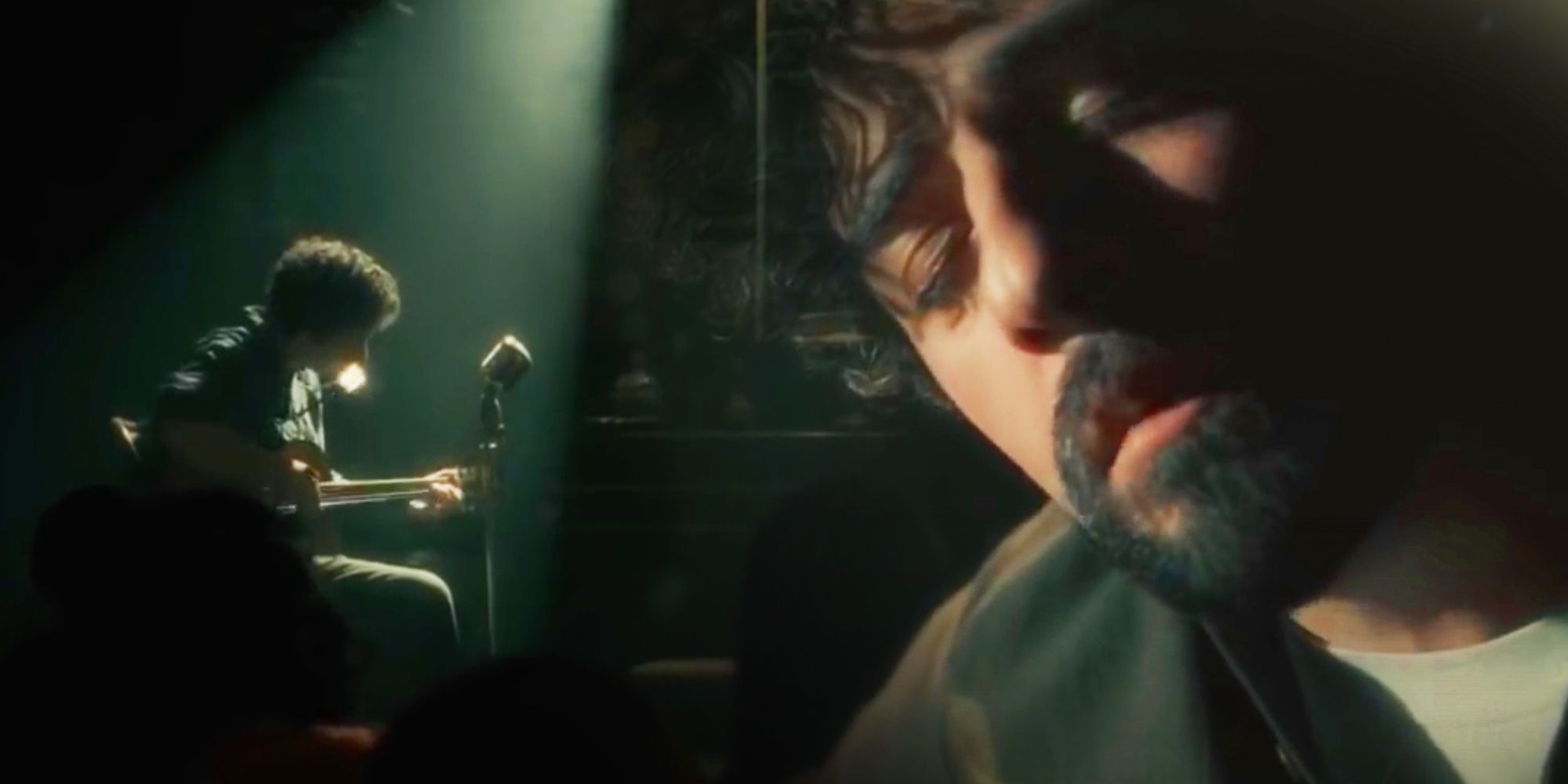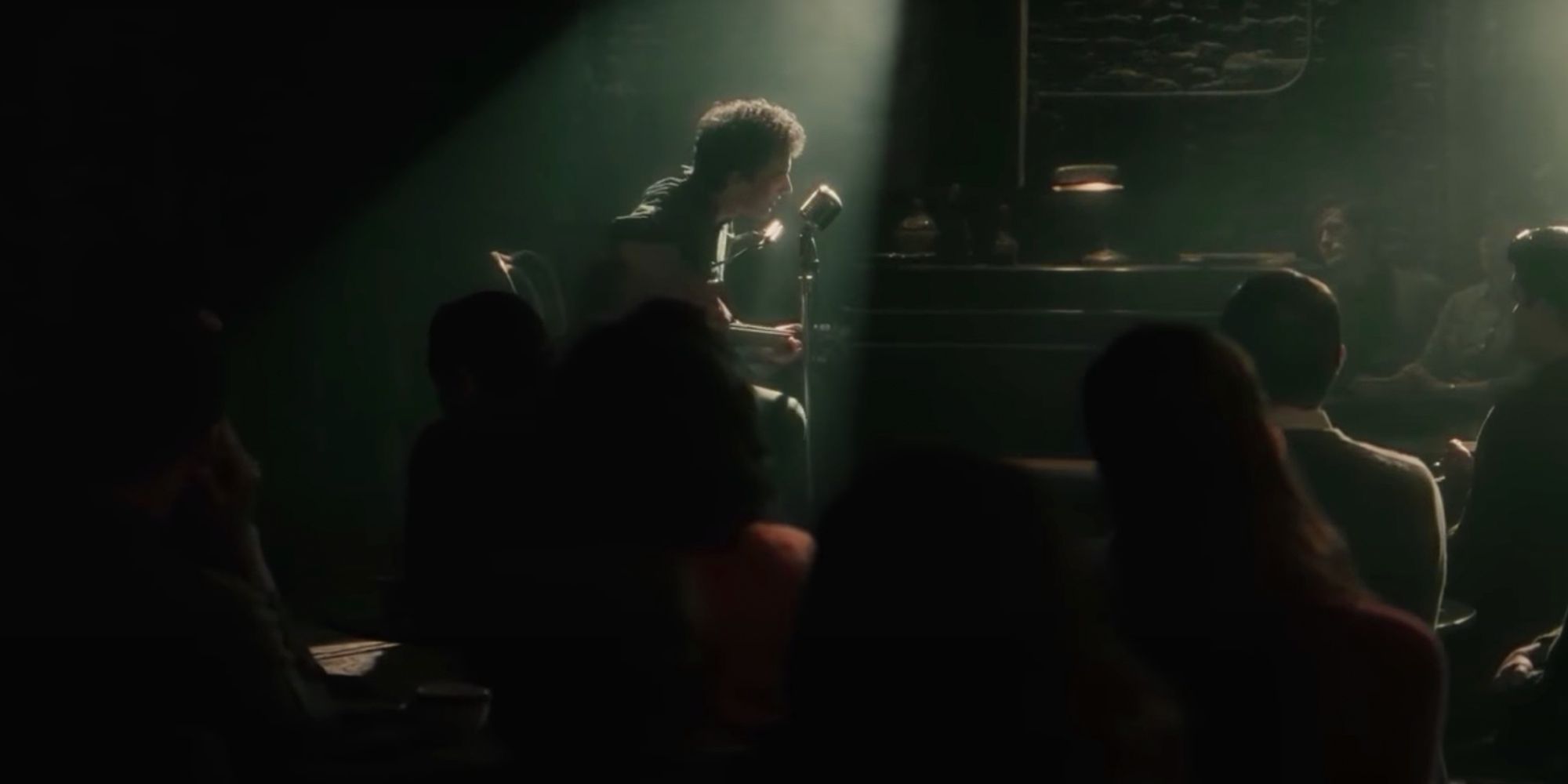Inside Llewyn Davis tells the story of a beleaguered Greenwich Village folk musician and ends with a "cameo" by the king of that famous musical scene: Bob Dylan. The Coen Brothers' exploration of New York's mid-century folk revival remains one of their most intimate and memorable movies to date, and a particularly memorable scene occurs towards the end when a young Bob Dylan, played by Benjamin Pike, performs directly after Oscar Isaac's Llewyn Davis at the famous Gaslight Café.
Davis as a character serves as a way for the Coen Brothers to explore the frustrations of creative life. In the film, after losing his singing partner to suicide, he has gotten used to playing low-key gigs and experiences a particularly ill-fated week that ends with him returning to the same venue where he plays the movie's opening song, completing a circular odyssey that leaves him trapped in his own form of purgatory.
In the film's closing moments, Davis delivers an impassioned final performance in Greenwich Village's Gaslight Café, before Pike's Bob Dylan takes to the stage. In this moment, Dylan is used as a symbol of the changing times, with Davis looking on as he experiences the birth of a folk superstar who would, in real life, go on to overshadow his contemporaries. Davis, who is partly based on folk legend Dave Van Ronk, is the Coen Brothers' representative of those contemporaries - a die-hard folk fan who, in this final scene, is confronted with the man who would do what he can't: usher in a musical revolution.
The Musician Was Bob Dylan
Pike's Bob Dylan shows up for only a few seconds in the film's closing scenes, but his appearance is significant. Inside Llewyn Davis' final moments take place in the famous MacDougal Street venue. Most recently recreated for Marvelous Mrs Maisel, MacDougal Street played host to numerous legends of New York's folk revival scene of the 1960s, from Richie Havens and Dave Van Ronk to Bob Dylan, and it's Dylan who appears, in fictionalized form, on stage as the film draws to a close. As Davis returns to the bar following his last performance, a slight figure can be seen taking the stage in the background, sporting the harmonica neck holder that was a staple of Dylan's early performances. All doubt is removed when the mysterious figure launches into well-known Dylan tune, "Farewell."
Throughout Inside Llewyn Davis, the titular character has struggled to find his place amidst the booming folk music revival of the 1960s, even though he's at the epicenter of the phenomenon: NYC's Greenwich Village. On his journey, Davis is met with one failure after another as he tries to gain some traction as a commercial artist. As the movie draws to a close, he plays a final heartfelt rendition of "Fare Thee Well (Dink's Song)," a tune from his repertoire with his late singing partner. The profound performance is met with enthusiastic applause that quickly dies off as another musician takes to the Gaslight Café's stage.
But once Dylan appears, Davis is literally replaced by the now-iconic singer-songwriter who was, at the time the movie is set, doing much the same as Llewyn Davis: playing small gigs at venues like the Gaslight and hoping to make a name for himself. In the film, Davis finishes his set and walks outside to meet his "friend" in the alley. On his way out, Oscar Isaac conveys genuine intrigue by casting a curious glance at the artist on stage. The fictional Dylan's recital of "Farewell" piques Davis' interest partly because it's similar to his own "Fare-thee-well," but also because there's something engaging about the man on stage. In reality, Dylan would use the folk tradition to launch a musical career that would span almost every genre in existence. In Inside Llewyn Davis' final scene, the protagonist is witnessing the beginnings of this incredible real-life journey, and though he doesn't know it yet, the beginning of his own talent being overshadowed.
Dylan Signified The Changing of the Times
In the years following his arrival on the folk scene, the real-life Dylan would become the most prominent member of the movement, helping to bring folk into the mainstream during the 1960s before evolving into a much more nuanced and eclectic figure in popular music. The now-iconic artist would famously anger the folk scene's adherents by branching out and experimenting with other musical styles in the following years – most notably by "going electric" at the 1965 Newport Folk Festival. Inside Llewyn Davis takes place in 1961, right around the time Bob Dylan – set to be played by Timothee Chalamet in an upcoming biopic – was frequenting the Greenwich Village venues that showcased artists of the era. In reality, Dylan himself would go on to write a song that would encapsulate the very sentiment at the heart of Inside Llewyn Davis' closing moments. 1964's 'The Times They Are A-Changin'" explored the ongoing cultural shifts that took place throughout the 60s.
In Inside Llewyn Davis, these very shifts are at the core of the film's narrative. Davis himself is experiencing personal shifts with the death of his singing partner, the potential birth of his illegitimate son, and the looming death of his father. He is constantly on the verge of major breakthroughs but continually fails to actually make it. His audition for F. Murray Abraham's Bud Grossman doesn't pan out. He chooses to accept a quick $200 payment instead of ongoing royalties for his appearance on a song that eventually turns out to be a major hit, and he can't even seem to do something as simple as join the merchant marines because he owes previous dues. Davis is continually met with failure, and in the final moments of the film, is experiencing yet another of these failures. His rendition of folk-standard "Fare-thee-well" – itself a relic from Davis' past – is a genuinely moving moment that ranks as one of the best musical performances in a non-musical. But it's overshadowed by the appearance of Bob Dylan and his updated version of that same tune. Davis is then met by a shadowy figure in the back alley who proceeds to beat him for heckling a performer earlier in the night, before leaving Davis with a cold "Au revoir." At this point Davis has been bid "farewell" by both Bob Dylan and the alleyway assailant. He is being left behind by the changing times, and the characters in the film are enthusiastically saying "goodbye."
In his Coen Brothers incarnation, Dylan is yet to become the megastar he would, in reality, become. For the final scene in the film, French cinematographer Bruno Delbonnel, who also worked with the Coens on The Ballad of Buster Scruggs, created a hazy vision of the Gaslight Café, in which the fictional Dylan's figure represents something much larger than his thin frame suggests. The Dylan Llewyn Davis watches on stage is a folkie like himself, but his appearance represents much more. The Coen Brothers' Dylan is a momentous portent of the changing times, and it connects to the central theme of Inside Llewyn Davis: that creative success is often more determined by being in the right place at the right time and being the right person for the times, like Bob Dylan was in the 1960s.



